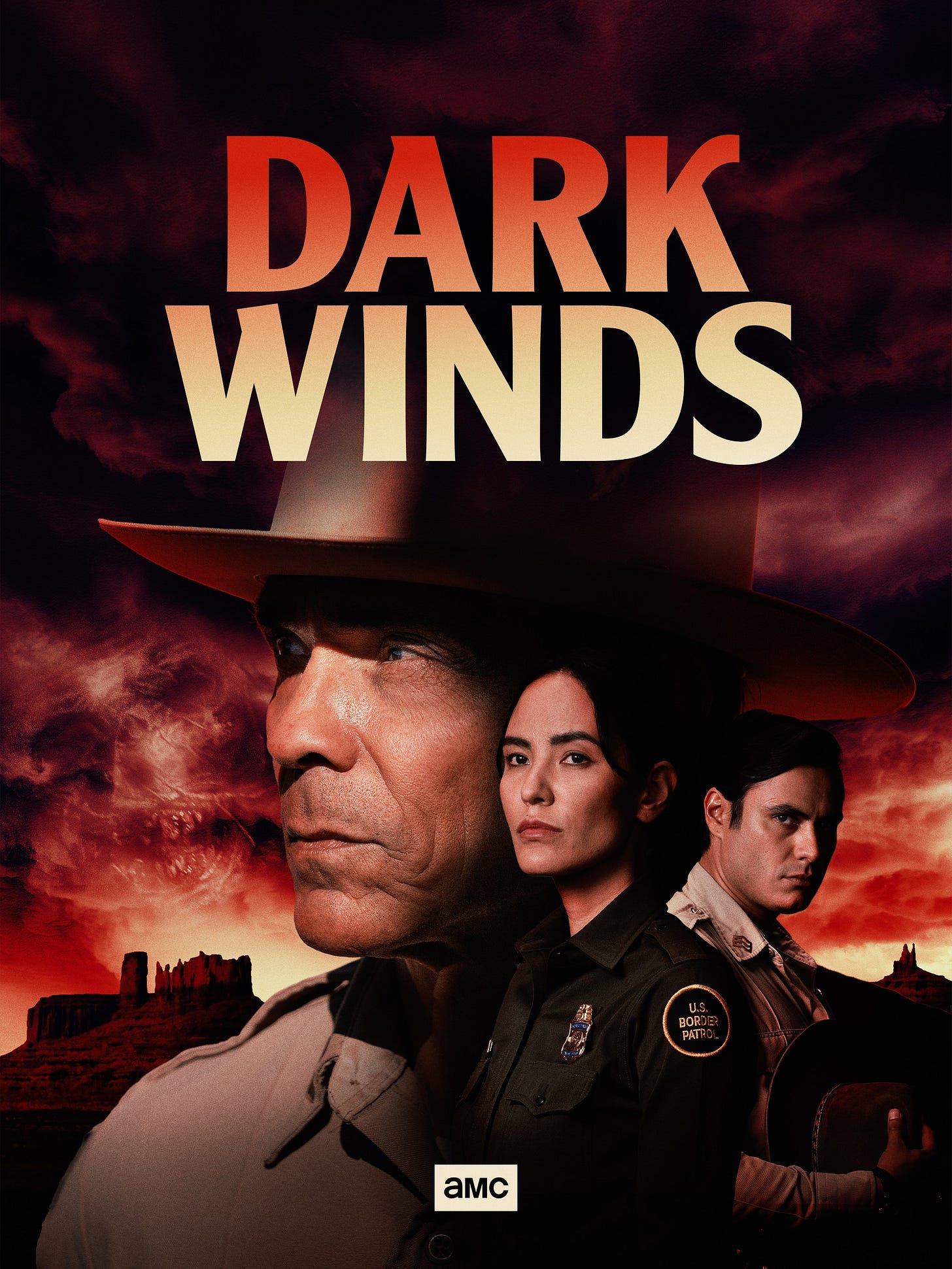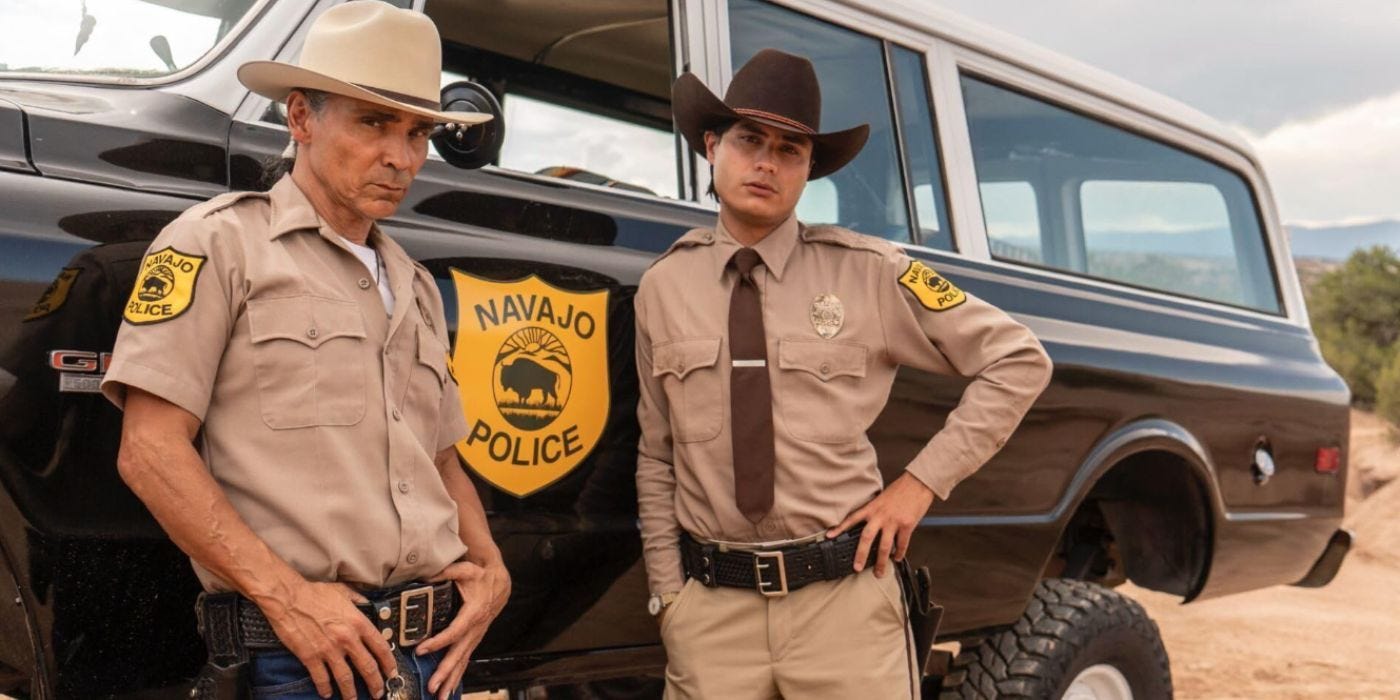Hillerman, Redford, And The Making Of Dark Winds; And Public Domain Series: Part 3
There’s something about silence in the desert. It doesn’t just settle. It speaks.
That’s the first thing the AMC series Dark Winds gets right. Stop me here if you’ve heard all this before. I admit I’m new to the series. Many, I’m sure, are old hands.
Now in its third season, Dark Winds arrived to critical acclaim, with its second season drawing a 146 percent increase in viewership. And yet, it still feels like it’s flying under the radar—a masterwork that hasn’t been fully claimed by the mainstream.
The show doesn’t chase spectacle. It lets the land breathe. Lets the wind carry what it needs to carry. Set in the early 1970s on the Navajo Nation, it follows Tribal Police Lieutenant Joe Leaphorn and his deputy, Jim Chee, as they investigate crimes that don’t just threaten lives—they rattle the bones of history.
Zahn McClarnon’s portrayal of Leaphorn isn’t your typical TV detective. He doesn’t bark orders or crack wise. He listens. Watches. Moves like a man who knows pain doesn’t always announce itself. His silences speak louder than most monologues.
I’ve loved Tony Hillerman’s novels since I first stumbled upon them—drawn in by the sparse prose, the moral weight, the sense that justice wasn’t always clean, but it could still be pursued with dignity. His characters, Leaphorn and Chee, felt grounded. Human. A quiet kind of heroic.
But as the years went on, the tension in that admiration became harder to ignore. Hillerman was a white writer telling stories rooted in Diné (Navajo) culture. He handled that responsibility with more care than most, but the fact remains—he was telling someone else’s story. Certain spiritual practices, ceremonies, and cultural knowledge made their way into his pages. Not out of malice, but out of narrative convenience. And sometimes, even good intentions can overstep.
That’s what makes Dark Winds feel so different. Not because the story is new, but because the storytellers are. The series is created by Graham Roland (Chickasaw), with Indigenous voices like Chris Eyre (Cheyenne and Arapaho) shaping the direction. The lens has shifted. We’re no longer being told about the Navajo world—we’re being invited into it. And the difference matters.
Robert Redford deserves credit here. He’s been championing this adaptation for decades—long before networks were ready to listen. And George R.R. Martin brought the kind of industry weight that gets meetings on the books and green lights above the line. But the most important thing they did was step back. They supported, but didn’t steer. That kind of allyship—quiet, purposeful, behind the scenes—is rare. And necessary.
Still, this isn’t just about who’s behind the camera. It’s about what’s in the frame. Here’s a look at where the story has taken us so far:
Season One: Ghosts In The Dust
The series opens with a double murder, a plane crash, and a mystery that leads deep into the reservation and deeper into the past. But beneath the procedural beats, something more personal is unraveling. Leaphorn is haunted by the death of his son. Chee, just returned from college and working undercover for the FBI, is trying to figure out who he is—caught between duty and heritage.
The Buffalo Society, a militant group with ties to the crime, becomes the surface threat. But the real tension is internal—between Chee’s secrets, Leaphorn’s grief, and the land that remembers more than it reveals. Bernadette Manuelito, strong and steady, emerges as the moral center. By the end, the case is solved, but nothing feels resolved. The scars remain.
Season Two: Bloodlines And Boundaries
A new threat emerges—a car bombing, a mysterious assassin named Colton Wolf, and a series of deaths that strike close to Leaphorn’s heart. The investigation uncovers stolen identities, contaminated lands, and old betrayals. This season feels tighter, more intimate. It’s not just about justice—it’s about family, legacy, and the cost of carrying both.
Chee is now a private investigator, but he can’t fully escape the world he left. His relationship with Bernadette deepens, then frays. Leaphorn pushes forward, but the past keeps pulling at him. By the finale, justice comes—but at a cost. And once again, there’s no sense of triumph. Only endurance.
Season Three: The Wind Doesn’t Forget
The current season, still unfolding, has leaned even further into the political and spiritual tensions of the land. A series of suspicious deaths. Federal agents and Border Patrol encroaching on sovereignty. New characters with unclear motives. Old wounds that never healed.
Bernadette takes on more—both as a sergeant and as a woman asking what else life might hold. Chee remains between identities, between choices. And Leaphorn? He keeps walking, keeps carrying, keeps trying to make sense of a world where truth is fragile and justice is unfinished.
There are three episodes left in the season. The story hasn’t settled. But you can feel it building. Not toward a neat ending, but toward a reckoning. Because this show doesn’t believe in easy answers. It believes in weight. In legacy. In the wind that always brings the past back around.
Dark Winds doesn’t just represent progress in television. It signifies a shift in storytelling authority—from interpretation to authorship, from extraction to expression. It’s what happens when the people whose stories have been borrowed finally get the space—and the silence—to tell their own.
And perhaps the most powerful aspect is this: the show doesn’t explain itself. It doesn’t ask for permission or praise. It moves like the wind across the mesa—quiet, steady, and full of meaning for those who know how to listen.
The story’s not over.
But it’s being told from the inside now.
And that makes all the difference.
Public Domain Series: Part 3
I’ve been writing about the public domain for the past three weeks. This week, in the final part of the series, let’s look at some of the titles that entered the public domain this year. Every January, the locks on old stories loosen a little. And in 2025, the doors creak open for a new wave of voices—some iconic, some forgotten, all stepping into the light of the public domain.
Here’s a look at what’s now fair game for remix, reinterpretation, and revival:
Fiction that Shaped the 20th Century
A Farewell to Arms – Hemingway’s tragic wartime romance.
The Sound and the Fury – Faulkner’s stream-of-consciousness Southern epic.
A Room of One’s Own – Woolf’s quiet, brilliant defiance.
All Quiet on the Western Front (English translation) – a brutal meditation on war and disillusionment.
Red Harvest – Dashiell Hammett’s hard-boiled chaos that helped birth noir.
Mystery & Crime Finds Its Voice
The Roman Hat Mystery – the first Queen mystery, co-written under a shared pen name.
The Crime at Black Dudley – where Margery Allingham’s beloved sleuth Albert Campion got his start.
Rope – Patrick Hamilton’s chilling two-hander that inspired Hitchcock’s film.
Stories for the Stage (and Beyond)
Toad of Toad Hall – A.A. Milne’s stage adaptation of The Wind in the Willows.
Marriage and Morals – Bertrand Russell’s provocations on love, sex, and society.
Early writings by Wittgenstein – logic as language, philosophy as poetry.
Films that Broke Ground
Blackmail – Hitchcock’s first sound picture, moody and sharp.
The Cocoanuts – the Marx Brothers in full vaudeville absurdity.
Un Chien Andalou – Buñuel and Dalí’s surrealist short, still unnerving.
Pandora’s Box – Louise Brooks in a role that never really stopped echoing.
The Broadway Melody – the first sound film to win Best Picture.
The Skeleton Dance – Disney’s early experiment in musical animation.
From the Comics Page
Popeye steps out of the spinach can for the first time in Thimble Theatre.
Tintin takes his first steps in Tintin in the Land of the Soviets.
Buck Rogers enters the future via the Sunday comics.
Tarzan explores another lost empire.
Mickey Mouse talks (a little), but the real spotlight is on Horace Horsecollar.
Music, Now Unbound
Rhapsody in Blue and An American in Paris – Gershwin’s lush, cinematic Americana.
Jazz and Tin Pan Alley gems like:
Ain’t Misbehavin’
Stardust
What Is This Thing Called Love?
Singin’ in the Rain
Honeysuckle Rose
These aren’t just titles. They’re time capsules. And now they belong to all of us.
So let them live again—in remixes, reinterpretations, riffs. The past just handed us the mic. Let’s see who speaks next.
Next week, The Loyalty Test: How Autocracy Became the Plot.
That’s it for this week. Be good.







